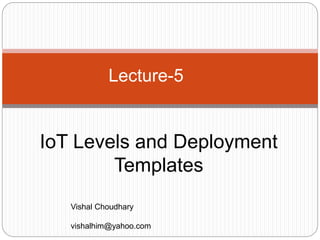Lecture 5
•Als PPTX, PDF herunterladen•
0 gefällt mir•431 views
IOT LEVELS
Melden
Teilen
Melden
Teilen

Empfohlen
Empfohlen
Weitere ähnliche Inhalte
Was ist angesagt?
Was ist angesagt? (20)
SDN( Software Defined Network) and NFV(Network Function Virtualization) for I...

SDN( Software Defined Network) and NFV(Network Function Virtualization) for I...
MULTIPLE CHOICE QUESTIONS WITH ANSWERS ON WIRELESS SENSOR NETWORKS

MULTIPLE CHOICE QUESTIONS WITH ANSWERS ON WIRELESS SENSOR NETWORKS
Ähnlich wie Lecture 5
Ähnlich wie Lecture 5 (20)
Iot unit i present by JAVVAJI VENKATRAO SVEC,TIRUPATI

Iot unit i present by JAVVAJI VENKATRAO SVEC,TIRUPATI
Mehr von vishal choudhary
Mehr von vishal choudhary (20)
Kürzlich hochgeladen
Mehran University Newsletter is a Quarterly Publication from Public Relations OfficeMehran University Newsletter Vol-X, Issue-I, 2024

Mehran University Newsletter Vol-X, Issue-I, 2024Mehran University of Engineering & Technology, Jamshoro
This presentation was provided by William Mattingly of the Smithsonian Institution, during the fourth segment of the NISO training series "AI & Prompt Design." Session Four: Structured Data and Assistants, was held on April 25, 2024.Mattingly "AI & Prompt Design: Structured Data, Assistants, & RAG"

Mattingly "AI & Prompt Design: Structured Data, Assistants, & RAG"National Information Standards Organization (NISO)
Kürzlich hochgeladen (20)
Seal of Good Local Governance (SGLG) 2024Final.pptx

Seal of Good Local Governance (SGLG) 2024Final.pptx
Basic Civil Engineering first year Notes- Chapter 4 Building.pptx

Basic Civil Engineering first year Notes- Chapter 4 Building.pptx
Z Score,T Score, Percential Rank and Box Plot Graph

Z Score,T Score, Percential Rank and Box Plot Graph
Unit-IV; Professional Sales Representative (PSR).pptx

Unit-IV; Professional Sales Representative (PSR).pptx
Presentation by Andreas Schleicher Tackling the School Absenteeism Crisis 30 ...

Presentation by Andreas Schleicher Tackling the School Absenteeism Crisis 30 ...
Mattingly "AI & Prompt Design: Structured Data, Assistants, & RAG"

Mattingly "AI & Prompt Design: Structured Data, Assistants, & RAG"
Lecture 5
- 1. IoT Levels and Deployment Templates Lecture-5 Vishal Choudhary vishalhim@yahoo.com
- 2. The IoT system consists of several systems which includes: Database: Database can be either local or in the cloud and stores the data generated by the IoT device. Web Service: Web services serve as a link between the IoT device, application, database and analysis components. Analysis Component: This is responsible for analyzing the IoT data and generating results in a form that is easy for the user to understand. Application: IoT applications provide an interface that the users can use to control and monitor various aspects of the IoT system. Applications also allow users to view the system status and the processed data.
- 3. IoT level-1 A level - 1 IoT system has a single node/device that performs sensing and/or actuation, stores data, performs analysis and hosts the application. Level - 1 IoT systems are suitable for modelling low cost and low complexity solutions where the data involved is not big and the analysis requirements are not computationally intensive.
- 6. IoT level-2 A level-2 IoT system has a single node that performs sensing and/or actuation and local analysis. Data is stored in the cloud and the application is usually cloud-based. Level-2 IoT systems are suitable for solutions where the data involved is big; however, the primary analysis requirement is not computationally intensive and can be done locally.
- 9. IoT level-3 A level-3 IoT system has a single node. Data is stored and analyzed in the cloud and the application is cloud-based. Level-3 IoT systems are suitable for solutions where the data involved is big and the analysis requirements are computationally intensive.
- 12. IoT level-4 A level-4 IoT system has multiple nodes that perform local analysis. Data is stored in the cloud and the application is cloud-based. Level-4 contains local and cloud-based observer nodes which can subscribe to and receive information collected in the cloud from IoT devices. Level-4 IoT systems are suitable for solutions where multiple nodes are required, the data involved is big and the analysis requirements are computationally intensive.
- 15. IoT level-5 A level-5 IoT system has multiple end nodes and one coordinator node. The end nodes perform sensing and/or actuation. The coordinator node collects data from the end nodes and sends it to the cloud. Data is stored and analyzed in the cloud and the application is cloud-based. Level-5 IoT systems are suitable for solutions based on wireless sensor networks, in which the data involved is big and the analysis requirements are
- 18. IoT level-6 A level-6 IoT system has multiple independent end nodes that perform sensing and/or actuation and send data to the cloud. Data is stored in the cloud and the application is cloud-based. The analytics component analyzes the data and stores the results in the cloud database. The results are visualized with the cloud-based application. The centralized controller is aware of the status of all the end nodes and sends control
